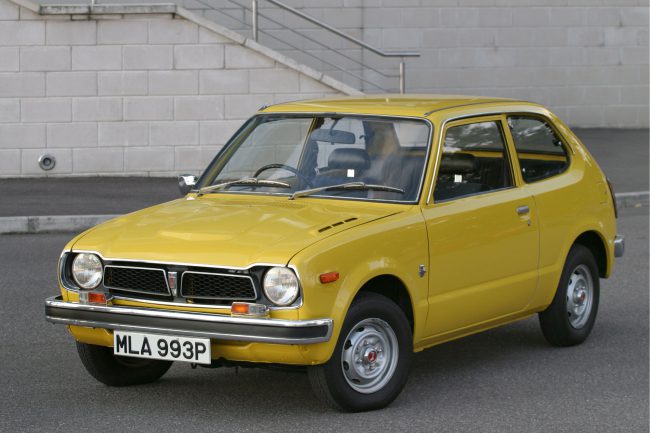
Honda Civic Engines
Content
Honda Civic is a representative of the class of compact cars that made a splash in its time and brought the Honda company to the leaders of automakers. The Civic was first shown to the public back in 1972 and began to be sold that same year.
First generation
The start of sales dates back to 1972. It was a small, front wheel drive car from Japan that was very ordinary and didn't really stand out from the competition. But later, it is the Civic that will become the very first production car, about which the whole Old World will talk. Cars of this generation had a 1,2-liter engine under the hood, which produced 50 horsepower, and the weight of the car was only 650 kg. As gearboxes, the buyer was offered either a four-speed “mechanics” or a Hondamatic automatic gearbox.
After the launch of sales of the car, the manufacturer took up the revision of the car line. Thus, in 1973, the buyer was offered a Honda Civic, which was equipped with a 1,5 liter engine and 53 horsepower. A variator or a mechanical “five-step” was installed on this car. There was also a "charged" Civic RS, which had a two-chamber engine and a family station wagon.
In 1974 the engine was updated. If we talk about the power of the power plant, then the increase was 2 "horses", and the car also became a little lighter. In 1978, the version with the CVCC engine was updated again, now the power of this motor has increased to 60 horsepower.
It is noteworthy that when, in 1975, US congressmen adopted special strict and tough emission requirements for cars, it turned out that the Honda Civic with a CVCC engine was 100% and even with a solid margin meets these new requirements. With all this, the Civic did not have a catalyst. This car was ahead of its time!
The second generation
At the heart of this Honda Civic car is the base of the previous one (the first generation Civic). In 1980, Honda offered the buyer the next new generation Civic hatchback (at the start of sales), they had a new CVCC-II (EJ) power unit, which had a displacement of 1,3 liters, its power was 55 “horses”, the engine had a special modified combustion chamber system. In addition, they created another engine (EM). It was faster, its power reached 67 forces, and its working volume was 1,5 liters.
Both of these power units were paired with three gearboxes to choose from: a four-speed manual, a five-speed manual and a new two-speed robotic box equipped with an overdrive (this box lasted only a year, it was replaced by a more advanced three-speed). A couple of years after the start of sales of the second generation, the model line was supplemented with cars in the back of a roomy family station wagon (had excellent sales ratings in Europe) and a sedan.
Third Generation
The model had a new base. The EV DOHC engine of these machines had a displacement of 1,3 liters (power 80 "horses"). But that was not all in this generation! The manufacturer introduced in 1984 a charged version, which was called the Civic Si. These cars had a 1,5-liter DOHC EW engine under the hood, which produced 90 and 100 horsepower, depending on the presence / absence of a turbine. The Civic Si has grown in size and has become as close as possible to the Accord (which belongs to a higher class).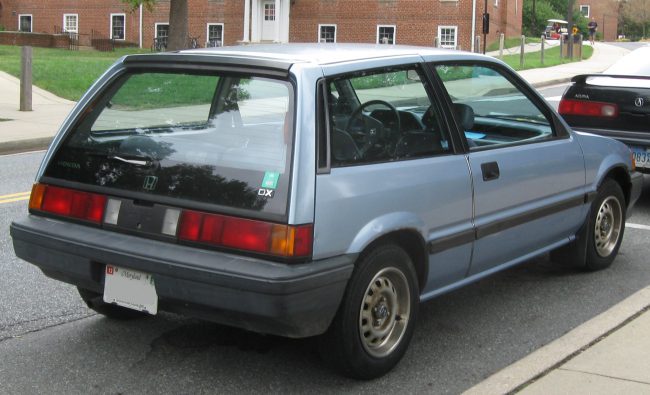
Fourth generation
The company's management set a clear goal for the development engineers of the Honda concern. It was to create a completely new modern efficient internal combustion engine, which was a breakthrough for the Civic. Engineers worked hard and created it!
The fourth generation of the Honda Civic was equipped with a 16-valve power plant, which the engineers referred to as Hyper. The motor had five variants at once. Engine displacement varied from 1,3 liters (D13B) to 1,5 liters (D15B). Motor power from 62 to 92 horsepower. The suspension has become independent, and the drive is full. There was also a 1,6-liter ZC engine for the Civic Si version, its power was 130 horsepower.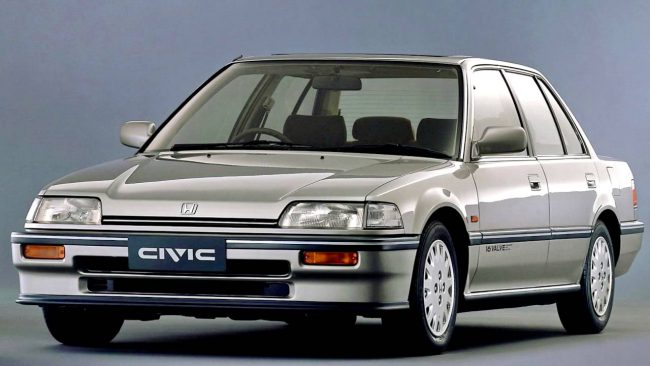
A little later, an additional 16-liter B1,6A engine (160 horsepower) appeared. For some markets, this engine was converted to use natural gas, but the engine markings remained the same: D16A. In addition to the already classic hatchback model, versions were produced in the body of an all-terrain station wagon and a coupe.
Fifth generation
The dimensions of the car have grown again. Engine engineers of the company again finalized. Now the D13B engine was already producing 85 horsepower. In addition to this power unit, there were more powerful engines - it was the D15B: 91 "horses", a working volume of 1,5 liters. In addition, a motor was offered that produced 94 hp, 100 hp, and 130 “horses”.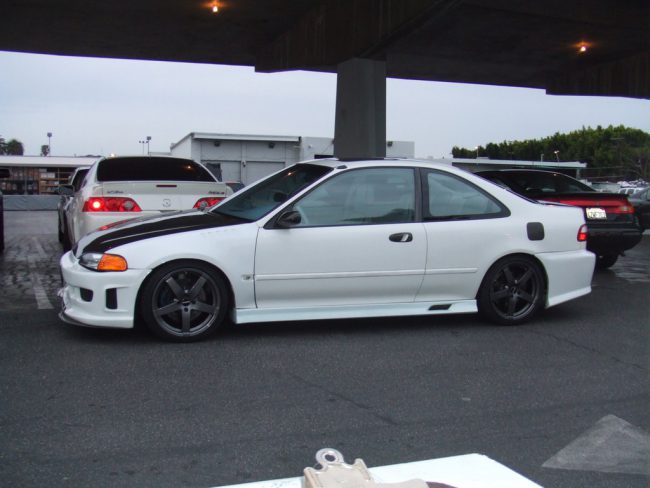
The manufacturer in 1993 offered a special version of this car - a two-door coupe. One year later, the line of engines was replenished, the DOHC VTEC B16A (1,6 l working volume) was added, which produced a solid 155 and 170 hp. These engines began to be put on versions for the American market and the Old World market. For the Japanese domestic market, the coupe had a D16A engine, the displacement of the power unit was 1,6 liters and produced 130 horsepower.
In 1995, Honda produced the ten millionth Honda Civic of this generation. The whole world heard about this success. The new Civic was bold and different in appearance. It was liked by buyers, which became more and more.
The Sixth Generation
In 1996, the Civic again stood out to the whole world in terms of its environmental friendliness. He is again the only one who was able to meet the so-called "California standards" for exhaust. The car of this generation was sold in five versions:
- Three-door hatchback;
- Hatchback with five doors;
- Two-door coupe;
- Classic four-door sedan;
- Family station wagon with five doors.
A large sector in production was given to cars with D13B and D15B engines, which had a power of 91 forces (displacement - 1,3 liters) and 105 "horses" (engine size - 1,5 liters), respectively.
A version of the Honda Civic was produced, which had an additional designation - Ferio, it had a D15B VTEC engine (power 130 "mare"). In 1999, a light restyling took place, which affected most of the body and optics. Of some design features of restyling, one can single out an automatic gearbox, from that moment it ceased to be a regime and became standard.
For Japan, they produced a coupe with a D16A engine (power 120 horsepower). In addition to this power plant, B16A engines (155 and 170 horsepower) were also offered, but they did not find their wide distribution to the masses, for some subjective reasons.
Seventh generation
In 2000, a new generation of the already legendary Honda Civic was released. The car took over the dimensions from its predecessor. But the dimensions of the cabin have been noticeably added. Along with a new body design, this car received a modern MacPherson strut suspension. As a motor, a new 1,7-liter D17A power unit with a capacity of 130 horsepower was installed on the model. Cars of this generation were also produced with old D15B engines (105 and 115 horsepower).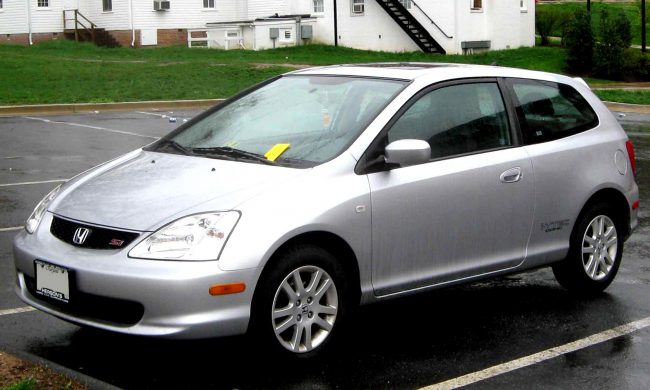
In 2002, a special version of the Civic Si was released, it was equipped with a 160-horsepower engine and a special hardy five-speed mechanics, which was borrowed from rally copies of the model. One year later, the Civic hybrid went on sale, it had an LDA engine with a displacement of 1,3 liters under the hood, giving out 86 “horses”. This engine worked with a 13-horsepower electric motor.
In 2004, the manufacturer made a restyling of the seventh generation of the model, it touched on optics, body elements, and also introduced a system that allowed the engine to be started without a key (for some model markets). There was a gas version for the Japanese market. It had a 17-liter D1,7A engine (105 horsepower).
Eighth generation
In 2005, it was presented to the public. A special chic is a futuristic tidy. This generation sedan does not look like a hatchback at all. These are two completely different cars. They have everything different (salon, suspension, optics, bodywork). In Europe, the Civic was sold in sedan and hatchback body styles (three and five doors). There were no hatchbacks in the US market, coupes and sedans were available. The sedan for the North American market differed from the similar version for the European market externally, but inside they were the same cars.
As for the motors, then everything is more complicated. In Europe, the Civic was produced:
- Hatchback 1,3 liter L13Z1 (83 horsepower);
- Hatchback 1,3 liter L13Z1 (100 horsepower)
- Hatchback 1,8 liter Type S R18A2 (140 horsepower);
- Hatchback 2,2 liter N22A2 diesel (140 horsepower);
- Hatchback 2 liter K20A Type R version (201 horsepower);
- Sedan 1,3 liter LDA-MF5 (95 horsepower);
- Sedan 1,4 liter Hybrid (113 horsepower);
- Sedan 1,8 liter R18A1 (140 horsepower).
In the USA, there were several other powertrains on cars of this generation:
- Sedan 1,3 liter Hybrid (110 horsepower);
- Sedan 1,8 liter R18A2 (140 horsepower);
- Sedan 2,0 liters (197 horsepower);
- Coupe 1,8 liter R18A2 (140 horsepower);
- Coupe 2,0 liters (197 horsepower);
And in the Asian markets, the model was produced only in the sedan and in the following versions:
- Sedan 1,4 liter Hybrid (95 horsepower);
- Sedan 1,8 liter R18A2 (140 horsepower);
- Sedan 2,0 liters (155 horsepower);
- Sedan 2,0 liter K20A Type R version (225 horsepower).
The hatchback Civic came with a five-speed and six-speed "mechanics", as an alternative, an automatic robot was offered. And starting in 2009, a classic five-speed automatic torque converter was added to the line of gearboxes (replacing the “robot”, which was not particularly bought). The sedan was originally available with a hydraulic automatic and manual transmission (five-speed and six-speed). The car with a hybrid engine was supplied only with a CVT.
In 2009, the Civic was restyled, it touched a bit on the appearance, interior and car trim levels. The Civic 8 had a charged version from Mugen, this “hot” car was based on the most powerful Civic Type R. The “hot” version had a K20A engine under the hood, which was spun up to 240 horsepower, the car was equipped with a standard 6-speed “mechanics”. The version was released in a limited edition (300 pieces), all cars sold out in 10 minutes.
Ninth generation
In 2011, introduced the new Civic, he was very handsome in appearance. Its all-metal grille, which turns into optics and with the addition of a chrome-plated company nameplate, is something of an automotive designer's art of the highest standard.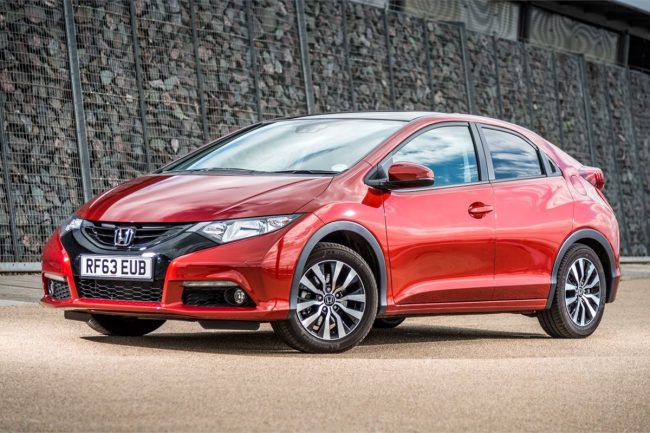
The cars are equipped with R18A1 engines with a displacement of 1,8 liters (141 horsepower) and R18Z1 engines with the same volume and 142 horsepower. Also, a little later, this engine was set up a little differently, it was labeled R18Z4, had the same power (142 horsepower), but had slightly reduced fuel consumption.
Table of power plants installed on the model
| Engine | Generations | ||||||||
|---|---|---|---|---|---|---|---|---|---|
| 1 | 2 | 3 | 4 | 5 | 6 | 7 | 8 | 9 | |
| 1.2 l, 50 hp | + | - | - | - | - | - | - | - | - |
| CVCC 1.5 l, 53 hp | + | - | - | - | - | - | - | - | - |
| CVCC 1.5 l, 55 hp | + | - | - | - | - | - | - | - | - |
| CVCC 1.5 l, 60 hp | + | - | - | - | - | - | - | - | - |
| EJ 1.5 l, 80 hp | - | + | - | - | - | - | - | - | - |
| EM 1.5 l, 80 hp | - | + | - | - | - | - | - | - | - |
| EV 1.3 l, 80 hp | - | - | + | - | - | - | - | - | - |
| EW 1.5 l, 90 hp | - | - | + | - | - | - | - | - | - |
| D13B 1.3 l, 82 hp | - | - | - | + | + | - | - | - | - |
| D13B 1.3 l, 91 hp | - | - | - | - | - | + | - | - | - |
| D15B 1.5 l, 91 hp | - | - | - | + | + | - | - | - | - |
| D15B 1.5 l, 94 hp | - | - | - | - | + | - | - | - | - |
| D15B 1.5 l, 100 hp | - | - | - | + | + | - | - | - | - |
| D15B 1.5 l, 105 hp | - | - | - | + | - | + | - | - | - |
| D15B 1.5 l, 130 hp | - | - | - | - | + | + | - | - | - |
| D16A 1.6 L, 115 hp. | - | - | - | + | - | - | - | - | - |
| D16A 1.6 L, 120 hp. | - | - | - | - | - | + | - | - | - |
| D16A 1.6 L, 130 hp. | - | - | - | - | + | - | - | - | - |
| B16A 1.6 l, 155 hp. | - | - | - | - | + | + | - | - | - |
| B16A 1.6 l, 160 hp. | - | - | - | + | - | - | - | - | - |
| B16A 1.6 l, 170 hp. | - | - | - | - | + | + | - | - | - |
| ZC 1.6 l, 105 hp | - | - | - | + | - | - | - | - | - |
| ZC 1.6 l, 120 hp | - | - | - | + | - | - | - | - | - |
| ZC 1.6 l, 130 hp | - | - | - | + | - | - | - | - | - |
| D14Z6 1.4 l, 90 hp. | - | - | - | - | - | - | + | - | - |
| D16V1 1.6 l, 110 hp. | - | - | - | - | - | - | + | - | - |
| 4EE2 1.7 l, 101 hp. | - | - | - | - | - | - | + | - | - |
| K20A3 2.0 l, 160 hp | - | - | - | - | - | - | + | - | - |
| LDA 1.3 l, 86 hp | - | - | - | - | - | - | - | + | - |
| LDA-MF5 1.3 l, 95 hp | - | - | - | - | - | - | - | + | - |
| R18A2 1.8 l, 140 hp | - | - | - | - | - | - | - | + | - |
| R18A1 1.8 l, 140 hp | - | - | - | - | - | - | - | + | + |
| R18A 1.8 l, 140 hp | - | - | - | - | - | - | - | + | - |
| R18Z1 1.8 l, 142 hp | - | - | - | - | - | - | - | - | + |
| K20A 2.0 l, 155 hp | - | - | - | - | - | - | - | + | - |
| K20A 2.0 l, 201 hp | - | - | - | - | - | - | + | + | - |
| N22A2 2.2 l, 140 hp | - | - | - | - | - | - | - | + | - |
| L13Z1 1.3 l, 100 hp | - | - | - | - | - | - | - | + | - |
| R18Z4 1.8 l, 142 hp | - | - | - | - | - | - | - | - | + |
Reviews
Whatever generation is discussed, the reviews are always laudatory. This is true Japanese quality. Moreover, Honda is always a step above all its Japanese competitors. This is an excellent quality, the main components, and the interior.
We could not find data on any systematic problems of engines or gearboxes on a Civic of any generation. There are rare negative reviews on the operation of the variator or automatic robot, but it seems that this is a problem of individual machines that were poorly maintained, rather than the “children's sores” of the entire generation. Also, Russian motorists sometimes scold the understated front bumper overhangs on modern Civic models. These overhangs do not tolerate the bumpy roads of Russian cities.
The metal of the Civic is traditionally of high quality, the cars resist corrosion quite well. Of the minuses, not the cheapest spare parts for models of all generations (especially the latest ones) can be noted, but this trend is visible among many automakers. Another disadvantage of the whole Honda as a whole is the departure of the official representative office of the company from the Russian market. This is a blow to all lovers of the brand of our country. But hopefully this is temporary.
As for the choice of car, it is difficult to give advice. Choose based on your own taste and your financial capabilities.

